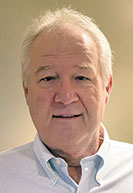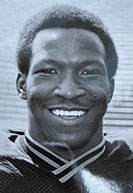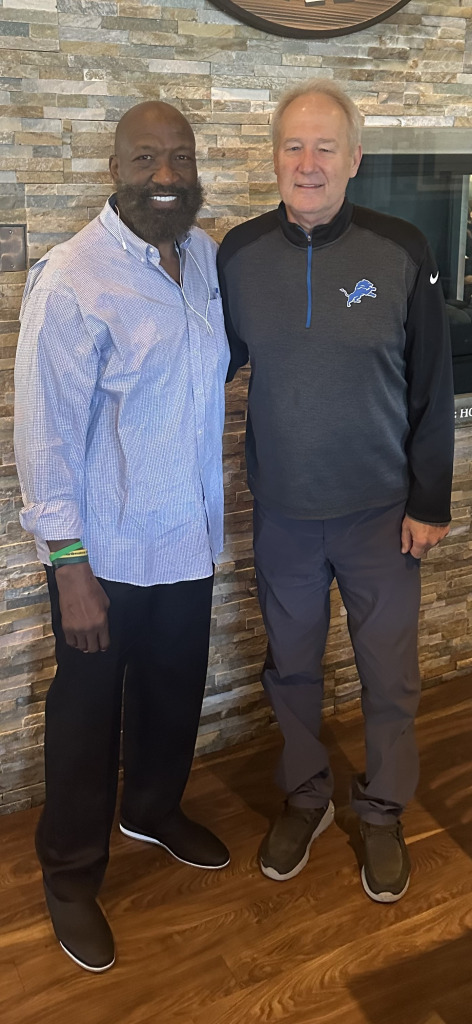Subscriber Benefit
As a subscriber you can listen to articles at work, in the car, or while you work out. Subscribe Now Editor’s note: See the bottom of this story for an update on Gary Forystek and Fred Arrington meeting for the first time since Sept. 24, 1977.
Editor’s note: See the bottom of this story for an update on Gary Forystek and Fred Arrington meeting for the first time since Sept. 24, 1977.
The fates of three football players collided with the shock and force of a thunderbolt the afternoon of Sept. 24, 1977, when Purdue and Notre Dame met at Ross-Ade Stadium.
One wound up in the hospital, his football career over.
Another wound up in the Pro Football Hall of Fame but paid for his admission with debilitating injuries.
And the third, the unintentional instigator, wound up living a pleasant, productive life outside of football.
Purdue and Notre Dame will meet on a football field for the 126th time on Sept. 14, and while every sporting event presents the possibility of a life-changing experience, it’s unlikely anything as momentous as what happened 47 years ago will occur.
That day, a player nearly was killed on the field, which in turn revived the career of a teammate. Had it not happened the way it did, at least a few lives might be notably different today. Destiny had more than one date that day.
Hit hard
Notre Dame was a heavy favorite. It had lost just three games each of the past two seasons under coach Dan Devine, but the alums—accustomed to the success and charisma of predecessor Ara Parseghian—were grumbling. When the Irish lost their second game of the season at Mississippi, “Dump Devine” stickers began popping up on car bumpers around South Bend.
A loss at Purdue in the third week would have marked the beginning of the end of Devine’s tenure. And it nearly happened. The Boilermakers, led by first-year coach Jim Young and freshman quarterback Mark Herrmann, were coming off a 5-6 season and in the early stages of a major rebuild, but they jumped to a 24-14 first-half lead that stunned the largest crowd (68,966) in Ross-Ade history to that date.

Devine pulled starting quarterback Rusty Lisch late in the first quarter in favor of Gary Forystek, a senior. Forystek, a high school all-American from Dearborn, Michigan, who had chosen Notre Dame over a long list of major programs, including Michigan, completed two of his first three passes to move the Irish to Purdue’s 26-yard line. But then, flushed from the pocket and forced to run, he collided head-on with Purdue’s senior linebacker, Fred Arrington.
The explosive impact reverberated through the stadium, stunning the fans into silence. By today’s rules, Arrington would have been penalized, perhaps ejected, for headhunting. Forystek lay motionless for 25 heart-stopping minutes, and an ambulance was called onto the field. Many of those in attendance feared the worst, including Alan Karpick, who is now the publisher of a Purdue fan publication, Gold and Black Illustrated.
“That was the hardest hit I’ve ever seen. Ever. Still,” Karpick recalls. “I thought Forystek was dead. I’m not kidding.”
Young, now 89 and living in Tucson, Arizona, shared that fear.
“It was one of the, if not the, hardest hits I ever witnessed,” says Young, who served as an assistant or head college coach every season but two from 1957 to 1994.
Adds Arrington: “I thought I had killed the guy. They put ammonia salt under his nose, and he wouldn’t move.”
Forystek, however, is quick to remind that he was making a mutual effort. His nickname among teammates was “Grater” because he ran like a road grater, moving obstacles out of the way.

“I was trying to run him over, and he was trying to kill me,” he says. “It was one-on-one.”
Forystek was taken to St. Elizabeth Hospital in Lafayette with a fractured collarbone and broken vertebrae near the base of his neck but was listed in stable condition. Word of that got back to both teams before the game ended, relieving everyone. Forystek recalls that he remained in the hospital for four days.
Devine sent Lisch back into the game for the rest of the half and the start of the third quarter, but with Notre Dame still trailing by 10 points late in the period, he grew desperate. He finally called for his third-string quarterback—a junior named Joe Montana.
Montana nearly threw an interception on his first pass but proceeded to lead the Irish to a 31-24 victory. Devine said afterward he wasn’t sure who would start the next game but stuck with Montana. Notre Dame won every game the rest of the season, including a victory in the Cotton Bowl for the national championship.
Purdue, failing to capture what could have been a season-propelling victory, stumbled to a 5-6 record.
Diverging paths
Arrington, Forystek and Montana have traveled wildly divergent paths since that afternoon in Ross-Ade, but each has done well.
Montana, of course, went on to play 16 NFL seasons and lead San Francisco to four Super Bowl titles. He was voted the league’s Most Valuable Player twice, was an obvious Hall of Fame selection in 2000 and is widely regarded as one of the greatest quarterbacks in history. His reputation is built on his clutch performances, such as the one he displayed in the comeback at Purdue. He earned the nickname “Joe Cool.”
But he has paid dearly for all the glory. He was removed from the field by ambulance once, too, in a playoff game against Buffalo in 1993, and has had more than two dozen surgeries since retiring in 1994.
Forystek never played in another game. He spent the rest of the season recovering from his injuries, although he was cleared to play in the Cotton Bowl if needed. His college career consisted of seven completed passes, most of those coming in a mop-up role. Declaring “I’ve never had the opportunity to prove myself,” he took Chicago’s offer of a free agent tryout in 1978 but was cut in August. He had another tryout with San Francisco the following year and was being tutored by assistant coach Sam Wyche but suffered a torn rotator cuff and retired in July.
There probably wasn’t much future in it, anyway. Montana had just arrived as a rookie.

“It was one thing after another,” he says now. “It just wasn’t my time. Nowadays I think I could have continued. Maybe I could have played in Canada, or caught on with another team.”
Arrington was named Purdue’s Most Valuable Player for the 1977 season, the first defensive player to win the award in 20 years, after setting a school record with 179 tackles. He was drafted in the 10th round by Detroit but was released before the preseason began. He returned to Purdue to complete the requirements for his degrees in business and computer science and then had a tryout with the New York Jets in 1979. A lower-back injury forced him out of football, but he’s kept himself in shape and is mostly pain-free today.
Arrington, a Fort Wayne native, is still well-remembered for his head-on collision with Forystek. It’s often the first thing mentioned when he’s introduced at Purdue functions, but it often doesn’t need to be stated. Purdue fans tend to know already, as Arrington was reminded when he attended the Purdue basketball team’s NCAA tournament victory over Tennessee last March in Detroit.
“I was sitting next to a guy and his grandkids,” he recalls. “I was talking to them, shooting the breeze, and we introduced ourselves. As soon as I said my name he said, ‘Oh, you’re the guy who knocked out the Notre Dame quarterback!’ He started introducing me to all these people around him. They were inviting me to their homes and wanting to get together.
“They don’t forget that play, man.”
Fate
One can only imagine how history would have been altered if not for Arrington’s devastating hit on Forystek.
If Montana had not played and Purdue had held on to win the game, Notre Dame likely would not have won the national championship, and Devine would have been fired after the season.
If Forystek could have played well enough to finish the game, he might have started the rest of the season, and perhaps positioned himself to play in the NFL.
If Montana had not gotten a chance to play that day, or had thrown an interception on his first pass and been yanked in favor of Lisch, who knows? He had not played on the varsity as a freshman in Parseghian’s last season. He came off Devine’s bench to lead two comeback victories in 1975 but had to sit out the ’76 season with injuries. He began the ’77 season as the third-string quarterback and, as Young recalls, appeared to be “in the doghouse.” He had been highly recruited for basketball out of high school as well, and it’s been reported he was thinking of asking Digger Phelps if he could join Notre Dame’s basketball team instead.
Regardless, it was clear Montana and Devine were not in sync. Tight end Ken MacAfee once recalled Montana’s place on the depth chart as a “weird deal.” Another teammate, fullback Steve Orsini, said Montana was often teased in later years about being a desperation measure.
“I’m sure in Coach Devine’s mind he was thinking, ‘Damn! I’m down to Montana,’” Orsini told a Montana biographer.
Arrington solved the conflict, although at Forystek’s expense.
Arrington, who had earned the nickname “The Hammer” because of his hard-hitting style long before injuring Forystek, wrote a letter to Forystek to apologize and wish him well. “A very kind letter,” Forystek remembers. Arrington also reached out to Montana by mail. One of Arrington’s Purdue teammates, Keena Turner, became a longtime teammate of Montana’s in San Francisco, which solidified their connection.
Arrington and his wife happened to be in Las Vegas one day when Montana was appearing across the street at Caesar’s Palace to promote a book. He walked over and asked a security guard to tell Joe that he was outside. Montana sent word to bring him in and introduced him to the crowd.
“He told me he would never forget me,” Arrington said. “He said, ‘You were a difference-maker in my life.’”
Arrington and Forystek both wound up in Michigan after limping out of football, within driving distance of each other. Arrington traveled the world in various executive capacities for IBM before retiring in 2012. Forystek worked in the high-tech software industry. Both stay busy today as consultants.
Their paths crossed briefly early this century at a high school football game. Forystek had taken over as coach of the Divine Child team in Dearborn. Arrington’s son played for St. Mary’s. Arrington watched from the sideline as a member of the chain gang. He remembers his son, who went on to play at Northwestern, knocking Forystek’s son out of the game for a couple of plays.
Arrington says he and Forystek were able to acknowledge each other occasionally and quietly during the game with brief “sidebar conversations” but did not have a real encounter. Forystek once told a reporter he looked for Arrington after the game but couldn’t find him.
Arrington would like to have that conversation today. After all, he and Forystek have never properly met. They live only 45 miles apart, Forystek in Plymouth, Michigan, and Arrington in Rochester Hills. They surely would have plenty to talk about.
“I need to close that chapter,” Arrington says. “It would make me feel better and hopefully help him, too.”
Forystek would be fine with that. He watched a grainy video of the play several years after the fact, and while he didn’t find it entertaining, he holds no bitterness. Just part of the game.
“I wouldn’t mind speaking to him and see where he’s at and talk about his life and what happened that day,” he says.
If only Montana could join them. They could dive deep into a discussion of the impact one fateful moment can have on a life.
The text below was added to this story after its original publication:
The meeting
Once they spotted one another, they immediately knew. It didn’t matter they had not seen one another in more than 20 years. Athletes recognize athletes.
“Gary!” Fred Arrington shouted.
“Fred!” Gary Forystek replied.
Fred Arrington and Gary Forystek met—truly met—for the first time since that fateful day in 1977 at the Rusty Bucket restaurant in Bingham Farms, Michigan, on Tuesday. This time it was nothing but cordial. The former combatants, one of whom had his life turned upside down in the first meeting, became instant friends.
“He’s a down to earth kind of guy, easy to talk to, very friendly,” Arrington said.” He’s just a good person.”
“It was great to meet him,” Forystek said. “He’s a really nice guy. We talked mostly about our sons and family, that kind of thing.”
Arrington and Forystek did have that that chance meeting in the high school game involving their sons, when they exchanged head nods and perhaps a few casual words but had never sat down and shared a conversation about their role in one another’s life. When they first saw one another at the restaurant they shook hands and embraced. Arrington apologized to Forystek for knocking him out of the game. Forystek laughed, and Arrington said he would pick up the check.
Although their lives have been highly successful beyond football, both personally and professionally, both needed a measure of closure. Arrington has felt some guilt for ending a player’s career while Forystek has been left to wonder “what if.” What if he could have finished the game, and perhaps won the starting job for Notre Dame for the rest of the season?
“Candidly, I think about it a lot,” Forystek said of the hit. “I’m not going to deny that. I’m not going to say the words ‘haunts’—but maybe that is the word.”
Forystek said he held no grudge against Arrington because he suffered several concussions throughout his football career and any number of opposing linebackers could have put him in the hospital—“although they probably wouldn’t have gotten me as well as Fred did.”
They talked about it over lunch.

“Did you see me coming?” Arrington asked.
“I saw you coming, but I was the kind of quarterback who tried to run people over,” Forystek said.
“Big mistake,” Arrington said. “I was looking for people like that. I thought I caught you off-guard.”
“No, I saw you, Fred. I was taking you head-on.”
They were nearly teammates at Notre Dame. Arrington narrowed his college choices out of high school to Purdue and Notre Dame, but Devine yanked the scholarship offer and awarded it to another player. That left Arrington with a built-in grudge against all Notre Dame players. He told Devine he was going to take it out on his players whenever possible.
“You just happened to be the victim of my frustration,” Arrington told Forystek.
Forystek, however, questions his decision to go to Notre Dame. He was part of a crowded quarterback room there, full of promising talents, and might have received a better opportunity elsewhere. Michigan coach Bo Schembechler wanted him so badly he was in his home at 9 a.m. the morning after Michigan lost to Stanford in the Rose Bowl. With the advantage of hindsight, he believes Michigan State might have been the best place for him to advance his football career. Or maybe he should have stuck with basketball, in which he led his high school team to a state championship, or baseball, where he also excelled.
Had he chosen any of those paths, he wouldn’t have been in Arrington’s way that fateful day in West Lafayette. All of that is ancient history now.
“Look, we’re going to be friends now,” Arrington told Forystek as they prepared to leave. “Let’s keep the communication open.”
Says Forystek: “I look forward to seeing him again.”•
__________
Montieth, an Indianapolis native, is a longtime newspaper reporter and freelance writer. He is the author of three books: “Passion Play: Coach Gene Keady and the Purdue Boilermakers,” “Reborn: The Pacers and the Return of Pro Basketball to Indianapolis,” and “Extra Innings: My Life in Baseball,” with former Indianapolis Indians President Max Schumacher.
Please enable JavaScript to view this content.

Next man up, is as vital to business, as sports!
So true, Steve. Many great careers in both are launched when someone goes down.
The collision of those three lives on that September afternoon in 1977 serves as a powerful reminder that destiny is often shaped by the most unexpected moments. In a single, brutal hit, the trajectories of their lives were irrevocably altered—one career cut short, another propelled to greatness, and the third left to ponder the cost of a single, fateful action. It’s a stark illustration of how the threads of fate can intertwine, sometimes cruelly, to redefine not just individual futures but the course of history itself. The profound truth here is that in the game of life, as in football, every moment carries the potential to change everything—often in ways we can never foresee or fully understand.
A historic military example that mirrors the fateful collision of lives on a single day is the Battle of Waterloo on June 18, 1815. The outcome of this battle drastically altered the course of European history.
Napoleon Bonaparte, who had returned from exile and reasserted control over France, faced a coalition of European powers determined to end his reign once and for all. The battle was fought between Napoleon’s French army and the allied forces of the Duke of Wellington and the Prussian army under Field Marshal Blücher.
The clash at Waterloo was intense and closely contested. In a matter of hours, the fate of Europe hung in the balance. A few pivotal moments during the battle had profound consequences:
The Delayed Attack: Napoleon’s decision to delay the start of the battle, waiting for the ground to dry, allowed more time for the Prussian army to regroup and arrive on the battlefield, strengthening the allied forces.
The Defense of Hougoumont: The fierce and successful defense of the farmhouse at Hougoumont by Wellington’s forces tied down a significant portion of Napoleon’s troops, preventing them from being used elsewhere on the battlefield.
The Late Arrival of the Prussians: The arrival of Blücher’s Prussian forces late in the afternoon turned the tide against the French. Their timely intervention crushed Napoleon’s flank, leading to his ultimate defeat.
Had any of these events unfolded differently, the outcome could have been drastically altered. Napoleon might have won the battle, reestablished his empire, and changed the trajectory of European history. Instead, the defeat at Waterloo ended Napoleon’s rule, led to his exile, and paved the way for a century of relative peace in Europe.
Much like the football game in 1977, where a single hit changed the lives of those involved, the Battle of Waterloo demonstrated how a few crucial decisions and moments can reshape the fate of nations and individuals alike.
Thanks for the history lesson, Don! Fate plays a huge role in world events as well as sports.